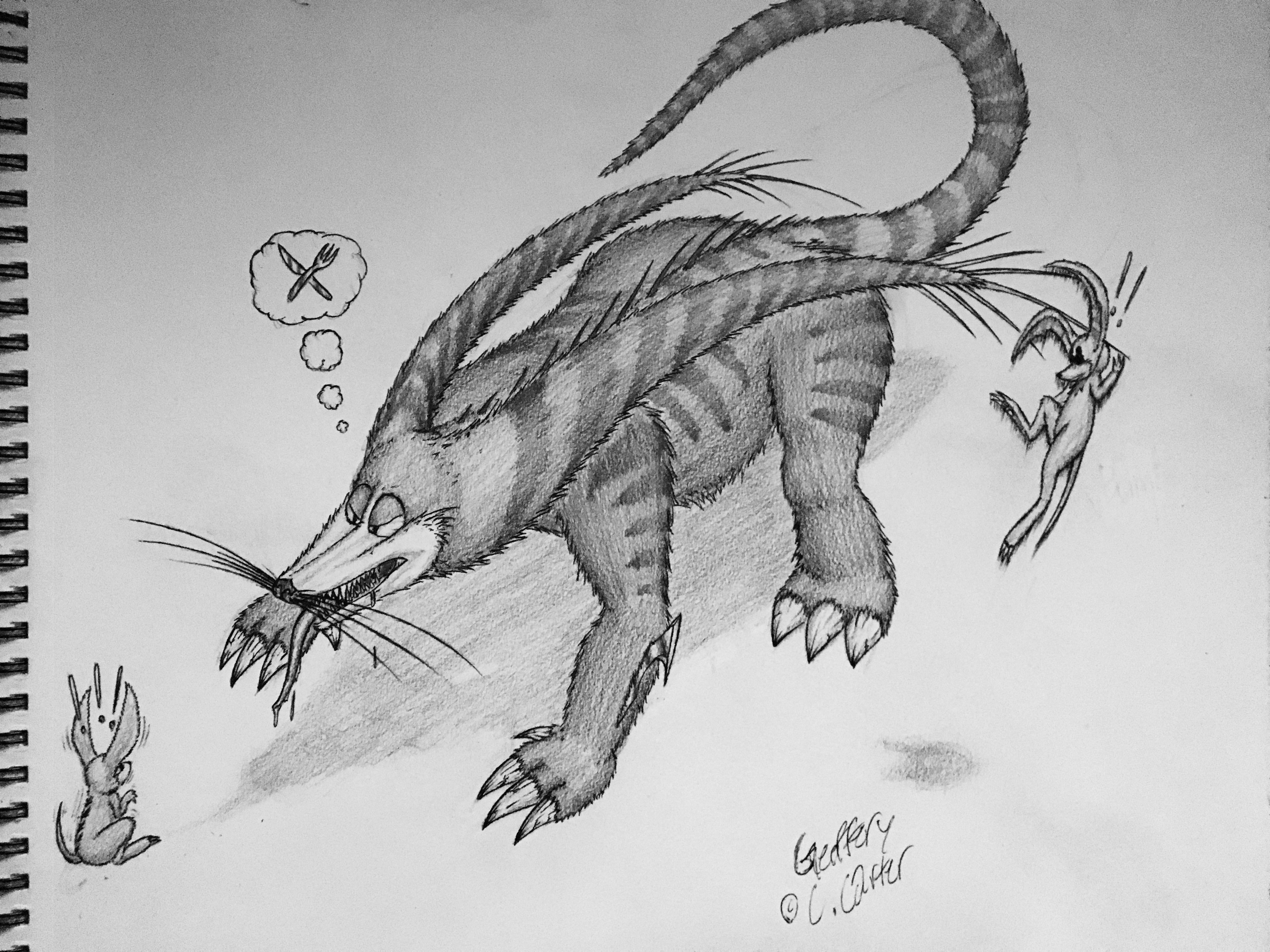HOME | DD
 GeofferyCCarter — Clepathurises
GeofferyCCarter — Clepathurises

#beast #fur #pen #pencil #rat #alien #aliencreature #animal #bear #bigears #blackandwhite #claws #creature #creaturedesign #fluffy #longears #scififantasy #tail #traditional #traditionalart #whiskers #scificreature #creatureconcept #fictionalspecies
Published: 2020-05-02 18:27:50 +0000 UTC; Views: 521; Favourites: 13; Downloads: 0
Redirect to original
Description
A concept for a Clepathurises: the common ancestor Clepathians evolved from. They are large, carnivorous rats about the size and build of a bear. Pictured here is a female, cornering a delicious snack.
These creatures once prowled the lands and early forests in the prehistoric eras of ancient Celor on all three of its major continents. Their long snouts were filled with sharp teeth for eviscerating flesh of anything they could bite and swallow. Upon their "arms" were barbs that would eventually become stilluses in Clepathians. At the tips of their ears and along their spines were whisker-like glands, used to emit and detect pheromones of other Clepathurises; these were lost as they evolved and became unnecessary. They also lost their whiskers as their brains grew, for they evolved a better sense of spatial reasoning. Many traits still persist in modern Clepathians, both physical, and instinctual true to Clepathurises being an alpha predator in its prime.
As the forest grew thicker, prey on the forest floor became scarce. The Clepathurises evolved over time with its changing biome: their hands becoming more dextrous, their limbs and claws longer, their build leaner and thinner and some became omnivorous, but most importantly was that they became more intelligent.
Interestingly, because Clepathurises were divided over the three contents of ancient Celor as they split, each of them evolved into a different intelligent species, albeit all sharing Clepathurises as their ancestor. These peoples were known as the Ke'too, Ba'hoo, and Ni'koo Clepathians.
The Ke'too have bodies almost identical to modern Clepathians, but instead adapted brown fur with dark blue spots, round pupils instead of downward slit pupiles, retained the long snout of the Clepathurises, and had ears that swept far back and upwards. This adaptation came from their continent being mostly wetlands, rich in aquatic life or creatures that dwelt in the muddy soil; their larger, flat feet allowed them to swim quite well, thrust into spongy wood of swamp trees to climb, and distribute their weight as to not sink into the mud, their snouts able to better trap fish, and their upswept ears able to stay above the water. Because of the unstable ground, they built their homes in treetops, creating impressive sprawls over the swamps. Among the three, the Ke'too became known for their clever practical ingenuity, becoming great engineers and architects. In addition, they also bred very quickly, becoming the most populous of the three.
The Ba'hoo had very similar ears and short snouts to modern Clepathians, but sharing the Ke'too round pupils, retaining sharp teeth and tusk-like fangs of the Clepathurises, and had much different hands, tails, and feet. Their digits were smaller, yet nimbler, and their tails forked into twin tails halfway down its length. This is true to their continent being comprised mostly of tall and hard trees, where appendages better suited for grasping branches where thrusting claws into trunks would not work. They hunted mostly small birds in the canopies, and occasionally large beasts as clans, being the last of these "proto-Clepathians" to escape from the nomadic hunter-gatherer way of life, as their stomachs could not process vegetation or fruits. Their fur was also colored the same as modern Clepathians, a dark charcoal gray or black, adapted to hide them in the darkness of the forest where they hunted. The Ba'hoo, true to their predatory instincts retained from the Clepathurises, were feared and respected warriors as the civilizations of the three arose and contacted each other. (The Ba'hoo were also the species which the first incarnation of Lahgtah was born of, as well where the Sulthrassa clan has its origins.)
The Ni'koo were, perhaps, the most unique. They too had longer snouts of the Clepathurises like the Ke'too, but they were herbivores. Their eyes were also downward slits, unlike the other two. The most striking distinction, however, was that they retained the full body-length ears of the Clepathurises, drooping all the way down to their waists(sometimes even longer), and digitigrade upon four-toed feet(much like Lahgtah, but with four toes instead of three.) Because of this, they had a very fat, heavy, and strong tail to act as a counterbalance to their almost dinosaur-like shape. They lived almost like herd-animals before their first civilizations arose, creating tight bonds and strict social customs among each other. Their fur was colored shades of light brown and white, and because of their fertile land, diet, and overall stronger bodies, were the first to become civilized of all the proto-breeds, but their metabolism was very slow and they did not reproduce quickly. The Ni'koo, having the luxury to advance as quickly as they did, made up for their lack of ingenuity and population with their social and diplomatic tact, as well as their head-start on the other two.
Though all three of these were their own species, they were all sentient and sapient, all came from Clepathurises, and would eventually combine their strongest traits to become the Clepathians as they are known today. How they became as such in spite of being reproductively is tale in its own right: one of war and pride, but also hope and miracles. In that sense, how three became one is as equal of a drama of how one became three.
Related content
Comments: 1

Clepathurise requires sustenance. Rato give it to her now!
👍: 0 ⏩: 0

























